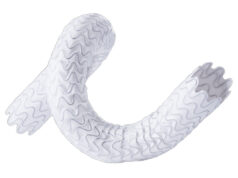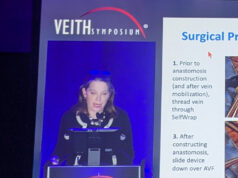 The AVeNEW study, a 24-month multicentre, international, prospective and randomised clinical trial has published results investigating percutaneous transluminal angioplasty (PTA) compared to PTA with placement of a covered stent for the treatment of arteriovenous fistula (AVF) stenosis.
The AVeNEW study, a 24-month multicentre, international, prospective and randomised clinical trial has published results investigating percutaneous transluminal angioplasty (PTA) compared to PTA with placement of a covered stent for the treatment of arteriovenous fistula (AVF) stenosis.
The covered stent group had improved target lesion primary patency (TLPP) compared to PTA alone, with comparable safety. Bart Dolmatch (Palo Alto Medical Foundation, Mountain View, USA) led the 24-site study that included 280 patients. The AVeNEW results have led to US Food and Drug Administration (FDA) clearance of the Covera covered stent for use in AVFs. In the authors’ view, the results demonstrated both safety and improved outcomes when using a covered stent to treat AVF stenosis in upper arm arteriovenous dialysis fistulae.
Stenosis development can limit flow in a haemodialysis arteriovenous fistula (AVF), say the authors of the study, which was published in Kidney International. This can lead to struggles with cannulation, spontaneous access thrombosis and other complications including “prolonged bleeding”—not to mention “ineffective dialysis” itself, they note.
Though angioplasty is often used to treat AVF stenosis, there have been randomised clinical trials showing that placing a covered stent following angioplasty of arteriovenous graft (AVG) venous anastomotic stenosis “affords superior target lesion primary patency (TLPP) compared to PTA alone”. In light of these results, the authors sought to examine if covered stent placement would improve outcomes when treating stenoses in AVFs, and conducted “the first large, prospective, randomised study” to address this question.
In total, 280 patients across 24 sites in the USA, Europe, Australia, and New Zealand were randomised in the trial, with 142 patients in the covered stent group and 138 in the PTA group. Dolmatch et al set out a few of the most common comorbidities among the cohort, including “hypertension (97.1%), dyslipidaemia (97.1%), type 2 diabetes mellitus (69.6%), coronary artery disease (35%), congestive heart failure (26.8%), and peripheral arterial disease (18.9%)”. The majority of those enrolled had an AVF in their upper arm (93.6%), with slightly more than half of the randomised AVFs having a brachiocephalic configuration (57.9%). Target lesions were mostly restenotic (73.2%), while slightly more than half of the target stenoses were in the cephalic vein arch (52.9%).
The primary safety outcome was 30-day freedom from adverse events requiring reintervention or surgery, or that facilitated or caused hospitalisation or death. The primary patency outcome was target lesion primary patency (TLPP) at six months, which was lost if there was a clinically-driven reintervention at the target lesion site, or abandonment of the AVF. Secondary hypothesis-tested outcomes included technically successful placement of the covered stent, TLPP at 12 months, and access circuit primary patency (ACPP) at six months. Other outcomes were observational and included TLPP and ACPP out to 24-months.
Regarding the primary outcome measures, the covered stent group demonstrated non-inferior safety to the angioplasty group (non-inferiority p=0.002) at 30 days, while TLPP was superior to the angioplasty group (78.7% versus 47.9%) at 180 days (modified intention to treat analysis; Kaplan-Meier survival analysis; p<0.001).
ACPP, while numerically better for the covered stent group, was not statistically superior at six, 12, or 24 months. The authors note: “While superior ACPP would have been desirable, it was not surprising that circuit patency was not statistically better for the covered stent group [since] circuit patency is multifactorial and represents the combined impact of target site patency, new stenoses, AVF thrombosis, and non-target stenoses treated at the index procedure that recur.”
Limitations to the AVeNEW study included the fact that investigators and staff were not blinded to treatment allocation, and 24-month attrition was 21% (largely due to mortality) which reduced the study population available for analysis. Regarding the ongoing challenge of deciding when to use PTA, covered stents, drug coated balloons, or other methods to treat AVF stenosis, the authors call for properly powered comparative randomised studies. Nevertheless, the authors conclude that the AVeNEW trial demonstrated that the Covera stent offered “statistically superior TLPP results and modest clinical benefit for patients” when compared to PTA alone.












